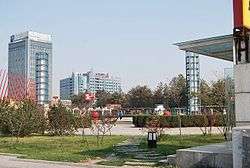Zichuan District
The Zichuan District (simplified Chinese:淄川区; pinyin: Zīchuān Qū) is one of eight divisions within the city of Zibo in the Chinese province of Shandong. As the largest district of Zibo, it is composed of a central urban zone of over 23 square kilometers [1]
and 17 towns that administer vast rural areas up to nearly 1,000 square kilometers. Initially founded in Han Dynasty, which dates back to 1,800 years ago, Zichuan has become an important industrial center not only in Zibo but also in Shandong.
Downtown Zichuan that is widely recognized by the local residents as Zichuan City, which is not administrative a real city though, got its reputation as a city because of its downtown area is distinctive. The downtown area has an estimated population of 20,000 while the total population of Zichuan District is over 670,000. South in Zichuan are twisting mountains which belong to part of the range of Shandong Hills, while north Zichuan are definitely plains where are more densely populated. As hometown to world-famous absurd fiction writer Pu Songling, who wrote one of his most famous book "Liaozhaizhiyi", Zichuan attracts thousands of tourists both abroad and domestic to pay a visit here every year.

History
During the first years of West Han Dynasty, Zichuan was set up with its Panyang as its first name as a county. Panyang means south of River Pan. Zichuan City was once a stone-walled city with four big gates in the Ming Dynasty and extended to its present scale mainly in the recent decades. Zichuan is also a name connected to river. Zi is a might river miles away to the west, and Chuan is river in Chinese.
After thousands of years slow development relying on agriculture, Zichuan had undergone an economic breakthrough since the discovery of its coal resource . The years when China was under colonial invasion a century ago the 1800s, it was the German who start dig coals first. Following the foundation of new China, or the People's Republic of China, in 1956, Zichuan was set up as a district and is one of the few two districts of Zibo within the next limited years.
Cityscape
Under the jurisdiction of Zichuan City, four street offices are set to take charge of the citizens' daily affairs such as education, sanitation and community services. The same as many of Chinese cities and towns, there is hardly any strict division between different facilities or functional components, all neighborhoods, schools, hospitals, business buildings and shops and are just scatter on the broad ground of the city and mix. Usually, the "city" is divided into these areas: Nanguan, Beiguan, Dongguan, Xiguan, Hongshan, Chengnan, Huangjiapu, etc.
Well-known landmarks of Zichuan City include Middle Streets, Liuquan Square, Lake Liuxian, Zichuan Garments Town, Liaozhai Town and Beishan Park.
Economy
Zichuan has a typical economic structure of heavily industrialized zones. In 2008, Proportion of the first industry, the second industry and third industry is 1.88∶63.63∶34.49. Total GDP the year is 25.85 billion Yuan. The large concentration of architectural ceramics of Zichuan make 60% of the total output of Zibo's ceramics industry. They also count for 30% of the GDP in Zichuan. Zichuan also boasts for Zichuan Garments Town-one of China's biggest cloths markets. An annual Domestic trading expo of quite large scale is held within the market.
The cost living of Zichuan and the whole Zibo area is among the lowest in East China-the most prosperous region in China. Housing costs are still on a reasonable level along of the development of the economy. Housing prices of it is the third or fourth-highest of the five districts in Zibo.
References
- ↑ Zichuan Government Archived June 24, 2009, at the Wayback Machine., Retrieved on Oct.28,09.
Coordinates: 36°38′37″N 117°58′01″E / 36.64361°N 117.96694°E